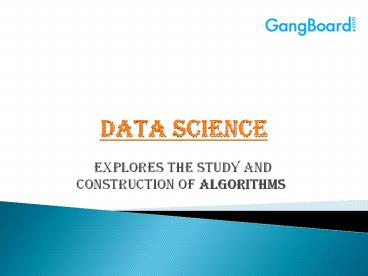Data Science - Algorithms - PowerPoint PPT Presentation
Title:
Data Science - Algorithms
Description:
Data Science is the territory of study which includes removing bits of knowledge from immense measures of data by the utilization of different logical techniques, calculations, and procedures. It encourages you to find concealed examples from the crude data. – PowerPoint PPT presentation
Number of Views:124
Title: Data Science - Algorithms
1
Data Science
- Explores the study and construction of Algorithms
2
Introduction
- In present reality, each assignment is being
robotized. Gone are the days when you needed to
stroll for twenty days or a ride a horse for
miles to get to a town or even do manual work,
for example, carrying heavy logs. - The term Data Science has developed as a result
of the advancement of scientific measurements,
data examination, and enormous data. - Data Science explores the study and construction
of algorithms that can learn from and make
predictions on data.
3
- Here are several Algorithms each in data science,
for example, you should know today with the goal
that our future can be more splendid. - Decision Tree
- Linear Regression
- Logistic Regression
- Support Vector Machine
- Naïve Bayes
- Gradient Boosting Algorithm
4
Decision Tree
- A Decision tree is a Decision support device that
uses a tree-like diagram or model of choices and
their potential results, including chance event
results, asset expenses, and utility. - It is one approach to show a algorithm that just
contains contingent control explanations.
5
Linear Regression
- In Statistics, linear regression is a direct way
to deal with demonstrating the connection between
a scalar reaction and at least one logical
factors. - A linear regression line has an equation of the
form Y a bX, where X is the explanatory
variable and Y is the dependent variable. The
slope of the line is b, and a is the intercept.
6
Logistic regression
- Logistics Regression is a factual model that in
its essential structure utilizes a calculated
capacity to demonstrate a paired dependent
variable, albeit a lot increasingly complex
expansions exist. - In regression analysis, logistic regression is
assessing the parameters of a logistic model.
7
Support Vector Machine
- Support Vector Machines are based on the concept
of decision planes that define decision
boundaries. - In this example, the objects belong either to
class GREEN or RED. The separating line defines a
boundary on the right side of which all objects
are GREEN and to the left of which all objects
are RED. - Any new object (white circle) falling to the
right is labeled, i.e., classified, as GREEN (or
classified as RED should it fall to the left of
the separating line).
8
Naïve Bayes
- Naive Bayes Classifiers rely on the Bayes
Theorem, which is based on conditional
probability or in simple terms, the likelihood
that an event (A) will happen given that another
event (B) has already happened. - Essentially, the theorem allows a hypothesis to
be updated each time new evidence is introduced.
9
Gradient Boosting Algorithm
- Gradient boosting is a machine learning technique
for regression and classification problems, which
produces a prediction model in the form of an
ensemble of weak prediction models, typically
decision trees.
10
THANK YOU
https//www.gangboard.com/big-data-training/data-s
cience-training































